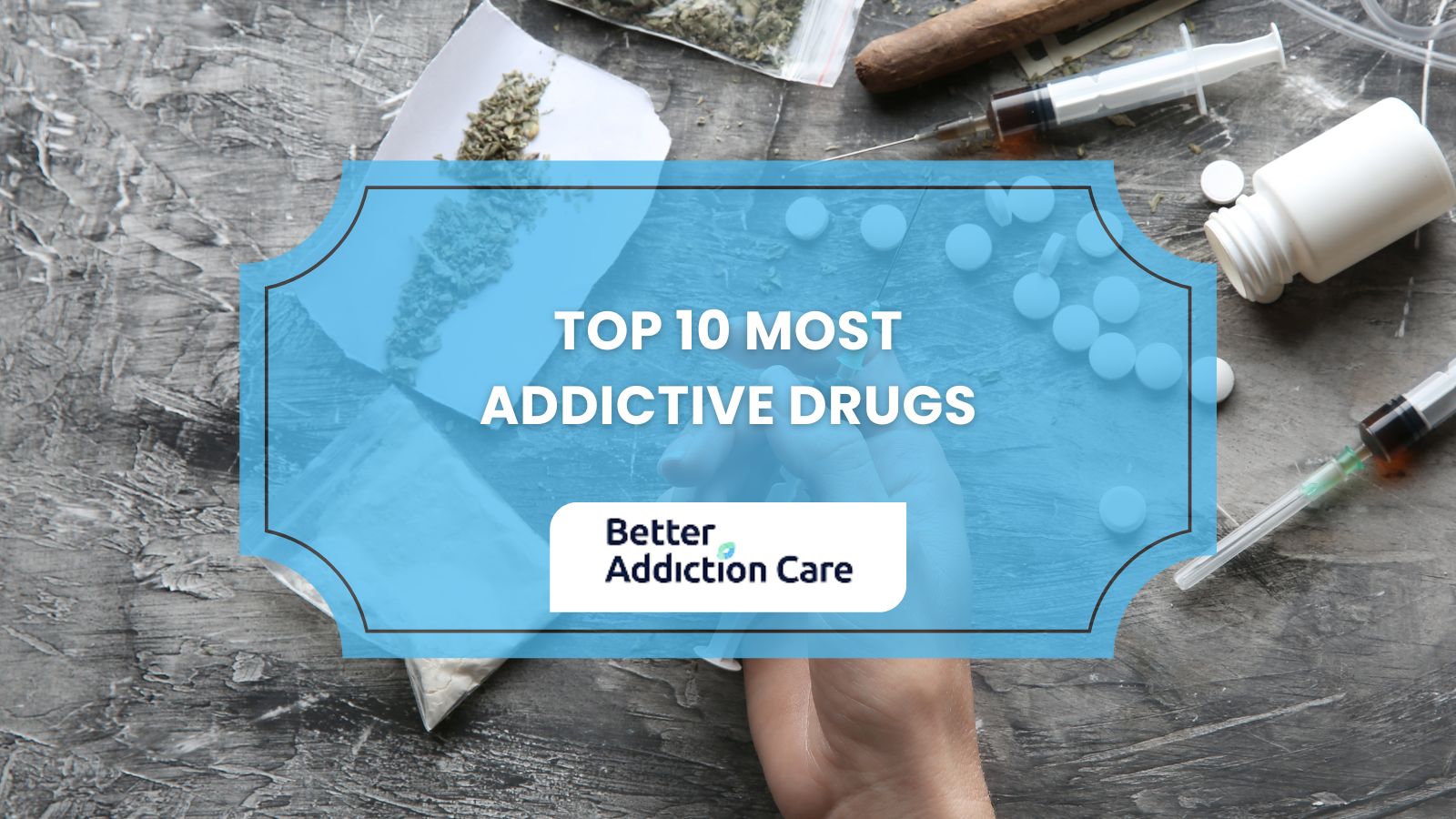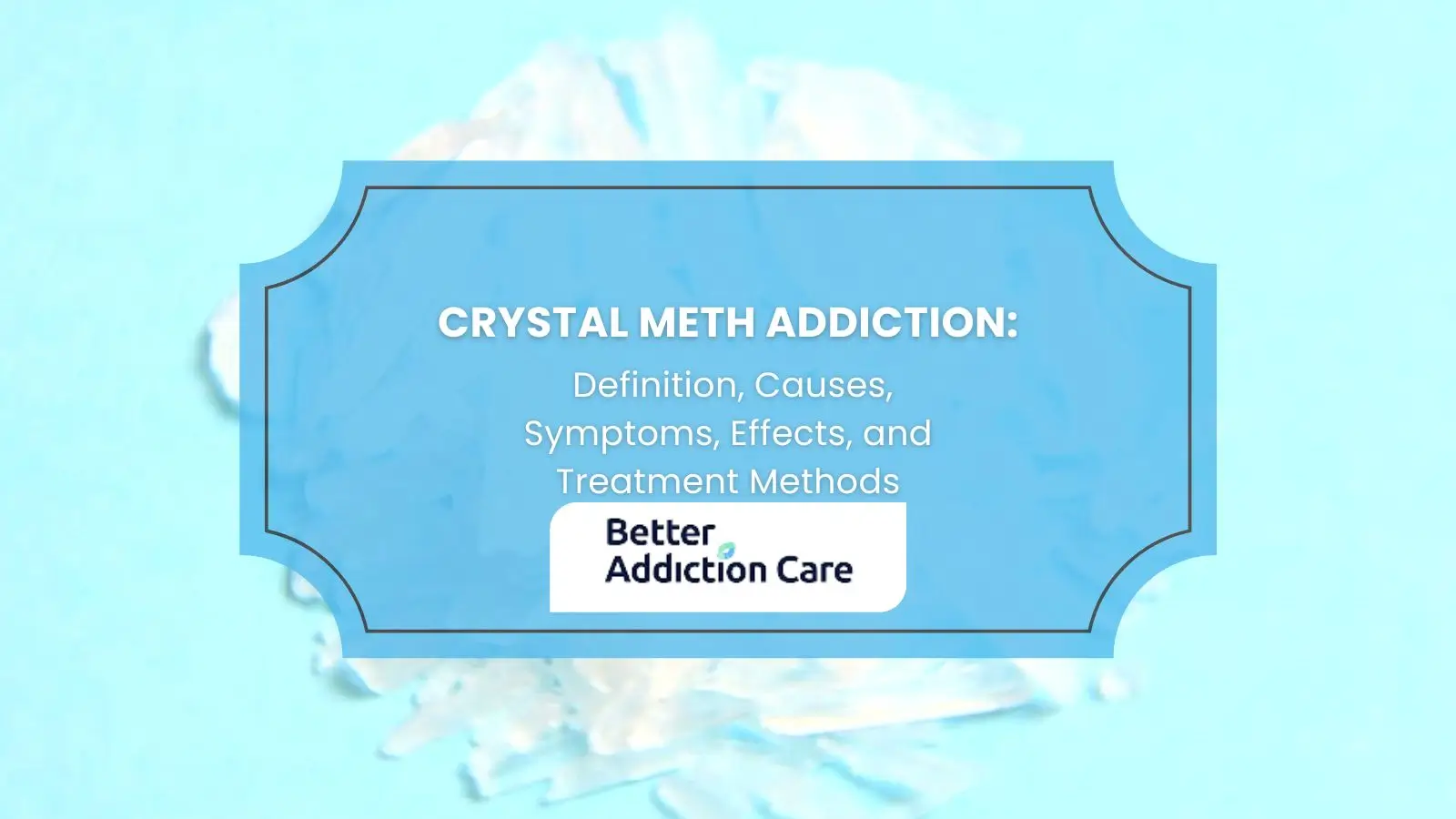Librium Addiction: Definition, Symptoms, Causes, Dangers, and Treatment
Librium addiction is when an individual becomes dependent on the benzodiazepine Librium, prescribed to relieve anxiety or manage alcohol withdrawal symptoms. Misuse of Librium leads to both physical and psychological addiction. Key symptoms of Librium addiction include increased tolerance, compulsive drug-seeking behavior, withdrawal symptoms like agitation and tremors, and inability to function without the drug. Causes of Librium addiction are prolonged or high-dose use, with individuals at risk who have a history of substance abuse or mental health conditions.
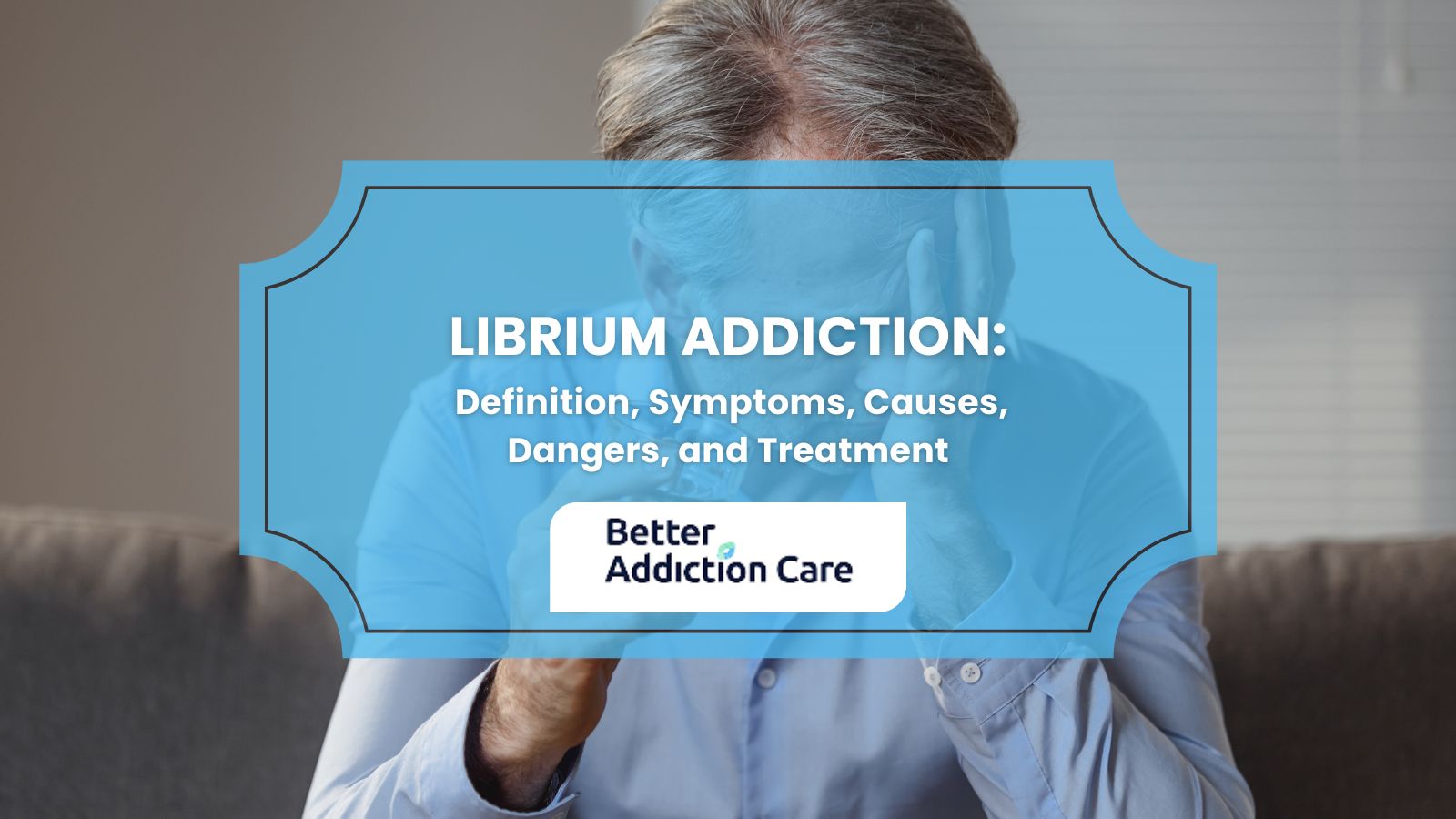
Librium addiction is when an individual becomes dependent on the benzodiazepine Librium, prescribed to relieve anxiety or manage alcohol withdrawal symptoms. Misuse of Librium leads to both physical and psychological addiction. Key symptoms of Librium addiction include increased tolerance, compulsive drug-seeking behavior, withdrawal symptoms like agitation and tremors, and inability to function without the drug. Causes of Librium addiction are prolonged or high-dose use, with individuals at risk who have a history of substance abuse or mental health conditions.
Librium addiction is dangerous and has an increased risk of overdose, respiratory depression, and impaired cognitive function. Treatment of Librium addiction involves a medically supervised taper to gradually reduce dependence, combined with behavioral therapies such as cognitive behavioral therapy (CBT) to address underlying triggers and prevent relapse.
What is Librium?
Librium, or chlordiazepoxide, is a benzodiazepine medication used for its calming effects on the central nervous system. The street names for Librium are downers, tranqs, bennies, benzos, blue bombs, L, and normies. Librium is prescribed to treat anxiety disorders, help manage symptoms of insomnia, and assist individuals undergoing alcohol withdrawal by reducing withdrawal-related symptoms like agitation and tremors. Librium enhances the effects of gamma-aminobutyric acid (GABA) in the brain, promoting relaxation, making it effective for short-term relief in these conditions, according to the research titled “Librium Capsule - Uses, Side Effects, and More” published by WebMD. Regardless of its potential for dependency, Librium is generally prescribed for a limited time and under strict medical supervision.
What is Librium Addiction?
Librium addiction is a compulsive need to use the benzodiazepine chlordiazepoxide (Librium), beyond prescribed limits, due to its calming and anxiety-reducing effects. Individuals with Librium addiction experience cravings, an increased tolerance, and significant withdrawal symptoms when not using the drug. The Diagnostic and Statistical Manual of Mental Disorders, Fifth Edition (DSM-5), categorizes substance use disorder criteria such as persistent cravings, unsuccessful efforts to cut down, and continued use despite harmful effects, which apply to Librium addiction when these behaviors interfere with daily life.
A key difference between physical dependence and addiction to Librium lies in behavior and control. Physical dependence occurs as the body adapts to the presence of Librium, leading to withdrawal symptoms when stopping.
How Does Librium Addiction Develop?
Librium addiction develops gradually as the body builds a tolerance to the drug’s effects, requiring higher doses to achieve the same sense of relief or relaxation. Librium is prescribed to manage anxiety or withdrawal symptoms, but users find that after some time the standard dose no longer has the same calming effect. This leads to increased usage and, eventually, dependency. The brain’s reward system adapts as tolerance builds and reinforces the need for Librium to maintain a sense of normal pattern or to avoid withdrawal symptoms. This cycle of Librium tolerance, increased dosage, and dependence quickly escalates into a full addiction, where stopping or reducing Librium use becomes physically and psychologically challenging.
How Common is Librium Addiction?
Librium addiction is common in the United States because, in 2019, 5.3 million individuals in the U.S. were estimated to misuse prescription tranquilizers or sedatives, including benzodiazepines like Librium. Data suggest that benzodiazepine misuse primarily affects adults aged 18-25, though older adults are also at risk due to high prescription rates for anxiety and insomnia management according to the research titled “Benzodiazepine Use and Misuse Among Adults in the United States” published by the National Library of Medicine. The misuse of Librium is higher in men than women, and socioeconomic factors, such as income and educational background, often correlate with misuse patterns.
What are the Symptoms of Librium Addiction?
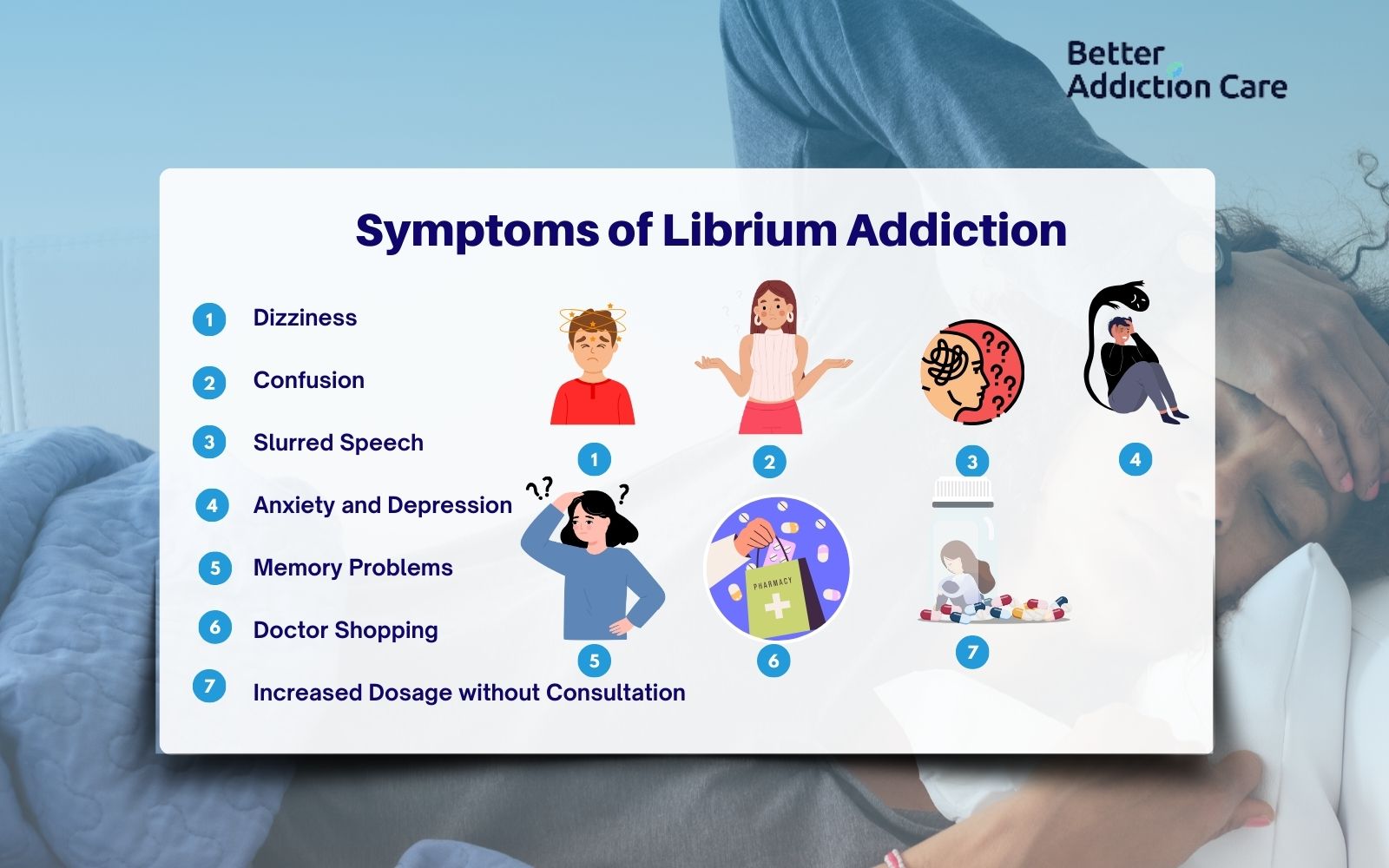
The symptoms of Librium addiction are dizziness, confusion, slurred speech, anxiety and depression, memory problems, doctor shopping, and increased dosage without consultation.
Below is a list of symptoms with brief explanations of each.
-
Dizziness: Individuals with Librium addiction experience dizziness due to the drug's effect on the central nervous system, impairing balance and coordination.
-
Confusion: Librium causes cognitive impairment, leading to disorientation and difficulty focusing, especially with prolonged use or high doses according to the research titled “LIBRAX” published by RXlist.
-
Slurred Speech: Slurred speech results from Librium’s sedative effects on the brain’s motor control functions.
-
Anxiety and Depression: Librium is used to manage anxiety, but dependence on the drug worsens anxiety and leads to depressive symptoms during withdrawal phases according to the research titled “Librium Addiction And Abuse.”
-
Memory Problems: Librium disrupts memory formation, leading to short-term memory loss, especially with long-term use, as noted in benzodiazepine studies according to the research titled “Benzodiazepine-induced anterograde amnesia: detrimental side effect to novel study tool” written by Kameron Kaplan, Holly Christian Hunsberger.
-
Doctor Shopping: Individuals turn to visit multiple doctors to obtain additional prescriptions and maintain the Librium supply.
-
Increased Dosage without Consultation: Addicted individuals begin taking higher doses without medical advice as tolerance builds, which is a risk factor for overdose and serious health complications according to the research titled “Estimating the Prevalence of Substance Use Disorders in the US Using the Benchmark Multiplier Method” published in 2022.
What are the Causes of Librium Addiction?
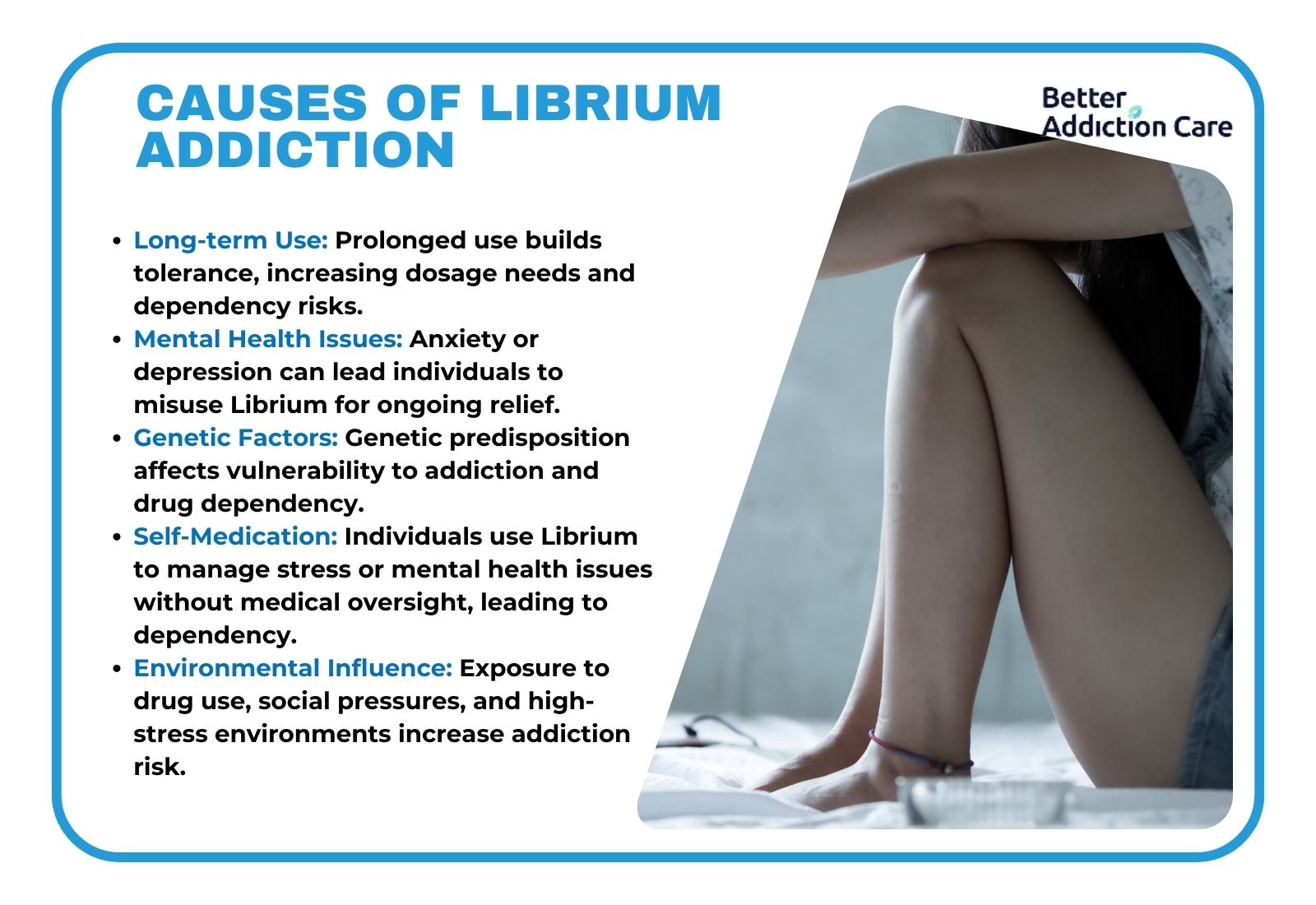
The causes of Librium addiction are long-term use, underlying mental health issues, genetic factors, self-medication, and environmental influences.
Below are the primary causes, explained:
-
Long-term Use: Long-term use of Librium leads to tolerance, requiring progressively higher doses to achieve the same effect. Prolonged benzodiazepine use, including Librium, increases the risk of addiction and dependency according to the research titled “Benzodiazepines: Uses, Dangers, and Clinical Considerations” published by the National Library of Medicine.
-
Underlying Mental Health Issues: People with mental health conditions, such as anxiety or depression, are more susceptible to Librium addiction as they may seek sustained relief from these symptoms. Pre-existing mental health disorders are at an elevated risk for benzodiazepine misuse according to the research titled “Librium Addiction And Abuse” published by the addiction center.
-
Genetic Factors: Genetic factors influence how individuals metabolize drugs and their vulnerability to addiction. Genetic variations increase susceptibility to benzodiazepine dependence according to the research titled “Genetics: The Blueprint of Health and Disease” published by the Board of Addiction Professionals South Africa.
-
Self-Medication: Some individuals turn to Librium to manage personal stress or untreated mental health conditions, which lead to unmonitored and excessive use. The self-medication cycle often escalates and causes dependency over time according to the research titled “The Self-Medication Hypothesis of Substance Use Disorders: A Reconsideration and Recent Applications.” published by Harvard Review of Psychiatry.
-
Environmental Influence: Environmental factors, such as exposure to drug use, social pressures, and high-stress environments, play a role in Librium addiction according to the research titled “Risky Substance Use Environments and Addiction: A New Frontier for Environmental Justice Research” written by Jeremy Mennis.
What are the Dangers of Librium Addiction?
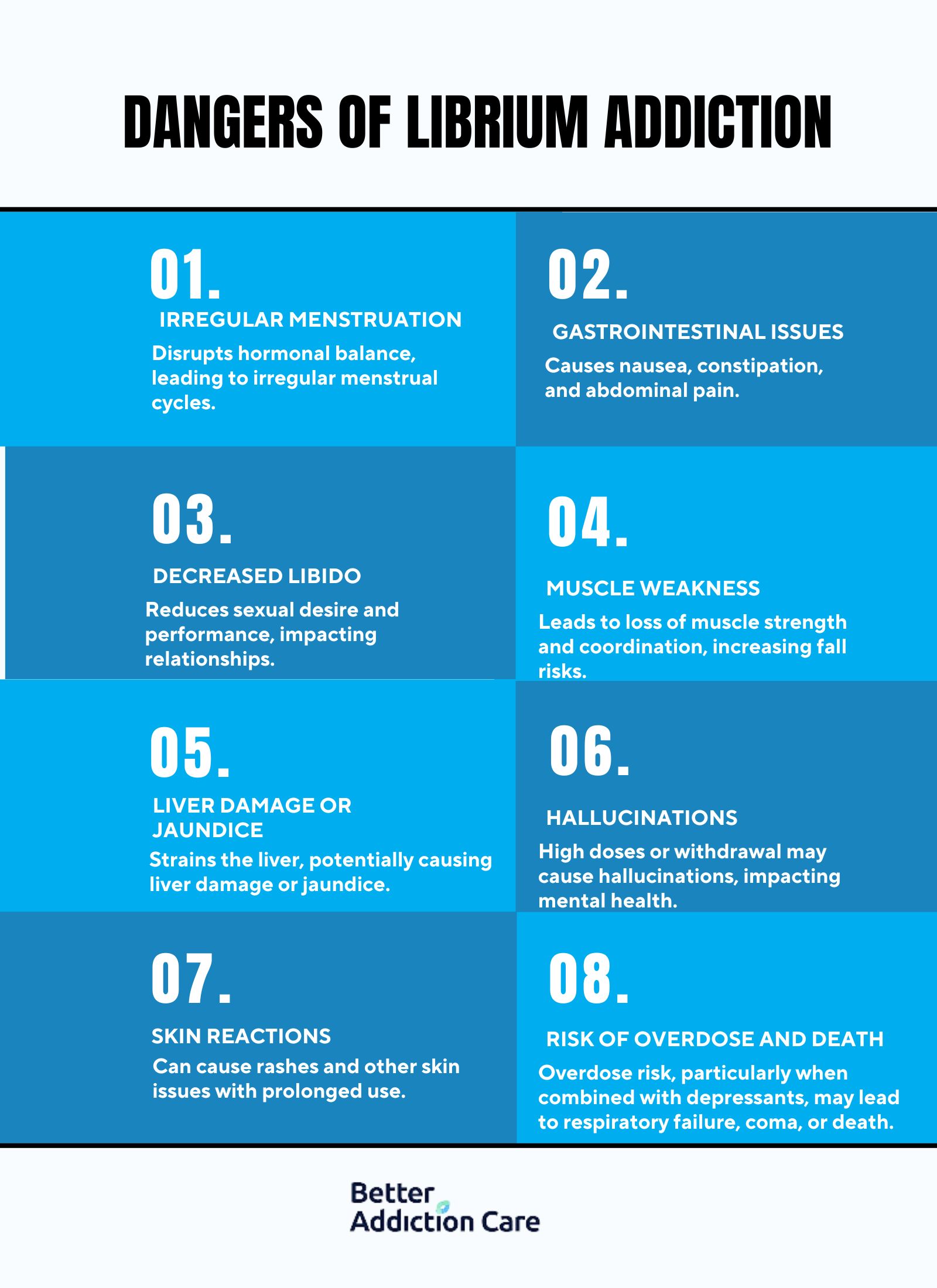
The dangers of Librium addiction are Irregular menstruation, gastrointestinal problems, changes in libido, muscle weakness, liver problems or jaundice, hallucinations, skin problems, and risk of overdose and death.
Below is a list of potential dangers associated with Librium addiction:
-
Irregular Menstruation: Librium disrupts hormonal balance, leading to irregular menstrual cycles in women, which complicates reproductive health.
-
Gastrointestinal Problems: Long-term use of Librium causes gastrointestinal issues, including nausea, constipation, and abdominal pain, as the drug affects digestive function.
-
Changes in Libido: Librium addiction affects sexual desire and performance, leading to decreased libido and sexual dysfunction, which badly impacts personal relationships.
-
Muscle Weakness: Sedative effects of librium result in decreased muscle strength and coordination, increasing the risk of falls and injuries, particularly in older adults.
-
Liver Problems or Jaundice: Liver problems or jaundice are the yellowing of the skin and eyes due to bilirubin buildup. Chronic use of Librium strains the liver, potentially leading to liver damage or jaundice.
-
Hallucinations: Hallucinations occur when people start seeing or hearing things that are not real. Withdrawal from Librium or high doses triggers hallucinations or severe mood changes, posing risks to the individual’s mental health and safety.
-
Skin Problems: Some Librium users experience skin reactions, including rashes or allergic responses, which worsen by prolonged use of the drug.
-
Risk of Overdose and Death: One of the most serious dangers of Librium addiction is the risk of overdose, which leads to respiratory failure, coma, or death, especially when combined with other central nervous system depressants like alcohol according to the research published by American Addiction Centres titled “Dangers of Mixing Valium and Alcohol or Drugs”.
How is Librium Addiction Diagnosed?
Librium addiction is diagnosed using criteria set by the Diagnostic and Statistical Manual of Mental Disorders, Fifth Edition (DSM-5) and the International Classification of Diseases (ICD-10). Health professionals assess for substance use disorder by evaluating specific criteria, including a pattern of use leading to significant impairment or distress, tolerance to the drug, withdrawal symptoms, and continued use despite adverse consequences, according to the research titled “Sedative, Hypnotic and Anxiolytic Use Disorder DSM-5 304.1 (F13.1)”.
Screening tests, such as the Alcohol Use Disorders Identification Test (AUDIT) and the Drug Abuse Screening Test (DAST), are selected to evaluate an individual's substance use history and assess the severity of addiction. Comprehensive evaluations often include interviews and self-report questionnaires to gain insight into the individual’s drug use patterns, mental health status, and potentially occurring disorders.
What are the Treatment Options for Librium Addiction?

The treatment options for Librium addiction include detoxification, medication-assisted treatment (MAT), therapy and counseling, inpatient treatment, outpatient treatment, and support groups.
Below is a detailed overview of each treatment type.
-
Detoxification: Detoxification is the initial step in treating Librium addiction that focuses on safely managing withdrawal symptoms as the drug clears from the body. The detoxification process takes several days to weeks and is typically conducted under medical supervision to ensure safety according to the study titled “Addiction Treatment” written by Michael Weaver, MD. The primary advantage is the support provided during withdrawal and the disadvantage is the potential for severe withdrawal symptoms if not managed properly.
-
Medication-Assisted Treatment (MAT): Medication-assisted treatment MAT combines medications with counseling to help manage cravings and withdrawal symptoms. Medications usually include less potent alternatives or sleep aids to manage withdrawal symptoms. MAT efficiently reduces cravings, but there is a risk of developing dependence on the medications used.
-
Inpatient Treatment: Inpatient treatment programs provide a structured environment for individuals with Librium addiction requiring intensive care. Patients stay at a rehabilitation facility for 30 days or longer, depending on their needs. Inpatient treatment offers comprehensive support and reduces exposure to triggers, but it is costly and requires a significant time commitment.
-
Outpatient Treatment: Outpatient treatment allows individuals to stay at home while attending therapy sessions and support groups. This flexibility makes treatment more accessible and less disruptive to daily life. It doesn't provide the same level of supervision and support as inpatient programs and recovery time varies based on individual circumstances.
-
Support Groups: Support groups provide a community environment to addicted individuals where they can share their experiences. Support groups offer the best peer support but they are combined with other treatment methods.
How to Prevent Librium Addiction Relapse?
To prevent a Librium addiction relapse, avoid triggers, develop a relapse prevention program, and indulge in long-term therapy. Identifying and avoiding triggers is essential, as familiar environments, people, or situations associated with previous drug use trigger cravings. It’s important to develop a personalized relapse prevention plan with the help of a therapist to avoid high-risk situations.
Long-term therapy, such as cognitive-behavioral therapy (CBT), is highly effective in helping individuals address underlying emotional issues and maintain sobriety. Engaging in support groups, like Narcotics Anonymous (NA), offers ongoing peer support, which is critical for long-term recovery.
How is Librium Addiction Connected to Other Prescription Drug Addictions?
Librium addiction is connected to other prescription drug addictions due to the similar effects that benzodiazepines and other depressants have on the brain. Individuals who misuse Librium also misuse other medications like Xanax, tramadol, or other benzodiazepines, as these drugs similarly affect the central nervous system, often creating a compounded addiction risk. The overlap occurs because users develop a tolerance to one medication and seek others to intensify or extend their effects.
Is Librium classified as a benzodiazepine?
Yes, Librium is classified as a benzodiazepine. Benzodiazepines, commonly referred to as "benzos," are a class of medications that act on the central nervous system to produce a calming effect. Librium (chlordiazepoxide) was one of the first benzodiazepines developed and is used for treating anxiety, insomnia, and symptoms related to alcohol withdrawal. Librium works by enhancing the effects of GABA, a neurotransmitter that reduces nerve activity, helping to alleviate symptoms of anxiety and agitation. Librium is effective for short-term therapeutic uses, but prolonged use leads to tolerance, dependence, and even a Librium or benzodiazepine addiction.
Can Librium Addiction Co-Occur with Tramadol Addiction?
Yes, Librium addiction can co-occur with tramadol addiction. Librium and Tramadol both impact the central nervous system. Librium impacts as a calming benzodiazepine and tramadol as a pain-relieving synthetic opioid. Librium and Tramadol increase the risk of dual dependence, as each drug’s effects mask withdrawal symptoms or side effects of the other, leading to increased dosages when taken together.
Related Articles
Treatment Centers in Virginia







